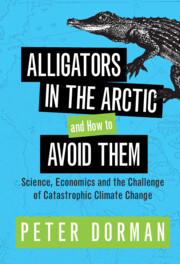 Alligators in the Arctic and How to Avoid Them
Alligators in the Arctic and How to Avoid Them Book contents
- Alligators in the Arctic and How to Avoid Them
- Alligators in the Arctic and How to Avoid Them
- Copyright page
- Dedication
- Contents
- Figures, Maps and Tables
- Preface
- Introduction
- 1 Carbon Accounting for Planet Earth
- 2 The Risks of Climate Change, or Why Carbon Budgets Need to Be Binding
- 3 Measurement
- 4 It’s about Fossil Fuels
- 5 Costs and Consequences
- 6 The Carbon Policy Toolkit
- 7 The Global Dimension
- 8 Political Economy for Alligators
- Appendix: Demystifying the Economics of Climate Change
- Notes
- References
- Index
6 - The Carbon Policy Toolkit
Published online by Cambridge University Press: 14 July 2022
- Alligators in the Arctic and How to Avoid Them
- Alligators in the Arctic and How to Avoid Them
- Copyright page
- Dedication
- Contents
- Figures, Maps and Tables
- Preface
- Introduction
- 1 Carbon Accounting for Planet Earth
- 2 The Risks of Climate Change, or Why Carbon Budgets Need to Be Binding
- 3 Measurement
- 4 It’s about Fossil Fuels
- 5 Costs and Consequences
- 6 The Carbon Policy Toolkit
- 7 The Global Dimension
- 8 Political Economy for Alligators
- Appendix: Demystifying the Economics of Climate Change
- Notes
- References
- Index
Summary
Voluntary or local renunciation of fossil fuels will not keep us within a carbon budget, and direct control along the lines of wartime rationing would be overbearing and inefficient. This leaves either carbon taxes or carbon permits as the main instrument. At a first approximation these are mirror images of each other: raising the price to reduce emissions or vice versa. Under uncertainty, however, taxes make prices predictable but leave emissions unpredictable, while permit systems do the reverse, which should be an argument for permits. Moreover, quantity controls better manage interdependent (multiple equilibrium) economic structures than price controls. Real-world implementation has been poor, as seen in the European Trading System and California’s Cap-and-Trade program. The culprits are weak targets, widespread exemptions, handouts to business and abundant offsets. The dismal experience of the Clean Development Mechanism shows that such offsets function mainly as loopholes. Better would be a system of permits with universal coverage, auctioned rather than given away, and not exchangeable for offsets. It should be accompanied by other policies to mitigate the distortions caused by rapid carbon price increases and to accelerate the development of non-carbon energy sources and non-carbon-using goods and services.
Keywords
- Type
- Chapter
- Information
- Alligators in the Arctic and How to Avoid ThemScience, Economics and the Challenge of Catastrophic Climate Change, pp. 150 - 189Publisher: Cambridge University PressPrint publication year: 2022


